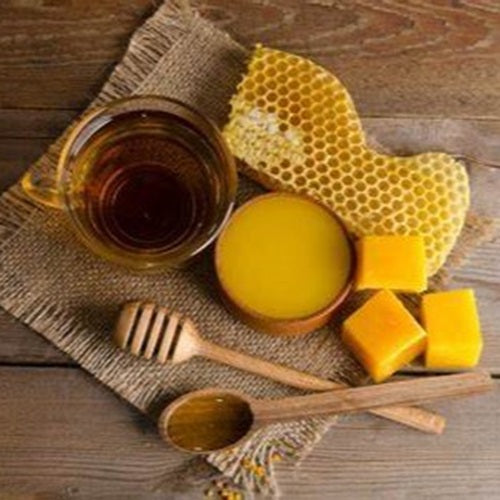Menu
LOOKING FOR BULK INGREDIENTS PRICING?

Benefits of Beeswax - Wholesale B2B Bulk Suppliers
The Wonders of Beeswax: Nature’s Golden Treasure
Beeswax is a natural, yellowish substance produced by honeybees. Often overshadowed by honey, this versatile material is essential to the hive and holds a treasure trove of uses and benefits for us. From skincare to candles, furniture polish, and even art, beeswax is a resource that has been utilized by humans for thousands of years. Let’s dive into the fascinating properties and practical applications of this incredible material.
How Beeswax is Made:
Beeswax production is a remarkable feat of biology and teamwork. Worker bees between 12 and 20 days old produce wax by consuming honey, then secreting it from special glands under their abdomens. They use this wax to build and repair the hexagonal honeycombs that store honey and pollen and nurture the young. The production process requires a tremendous amount of energy—bees consume about eight pounds of honey to make just one pound of wax!
Unique Properties of Beeswax:
Beeswax stands out among natural waxes due to its unique qualities:
- Melting Point: With a melting point of around 144°F (62°C), beeswax is stable yet pliable, making it ideal for diverse uses.
- Natural Fragrance: Its mild, honey-like scent adds a soothing aroma, particularly appealing in candles and skincare products.
- Long Shelf Life: Beeswax does not go rancid, making it a lasting choice in applications like cosmetics and polishes.
- Hypoallergenic and Non-Toxic: Gentle on skin, it is often used in natural skincare products.
Practical Applications of Beeswax:
- Natural Skin Care: Beeswax is widely used in creams, lotions, and lip balms because it locks in moisture without clogging pores. It’s rich in vitamin A, which supports cell turnover and helps keep skin soft and hydrated. Beeswax also has mild anti-inflammatory properties, which can soothe dry, irritated skin.
- Candle Making: Unlike paraffin candles, beeswax candles are natural and produce very little smoke. They burn longer, emit a warm golden glow, and release a subtle honey fragrance. Beeswax candles are also known to emit negative ions, which can help purify the air by neutralizing pollutants.
- Food Wraps: Eco-friendly beeswax wraps are a sustainable alternative to plastic wrap. Coated cotton cloths infused with beeswax provide a reusable, biodegradable way to keep food fresh. They can be molded around bowls and food items with the warmth of your hands and are washable, making them a great option for reducing plastic waste in the kitchen.
- Wood and Leather Care: Beeswax makes an excellent polish for wood and leather surfaces, adding a natural shine and protecting them from moisture. When mixed with oils, beeswax polishes are easy to apply, restoring the color and luster of wooden furniture, cutting boards, and leather goods.
- Art and Craft Supplies: Beeswax has been used in art forms such as encaustic painting—a technique where artists use molten beeswax to create textured, layered artworks. It’s also used in sculpting and as a base for certain crayons and pastels, providing a natural, eco-friendly medium for artists.
Environmental Benefits of Beeswax:
Beeswax is a renewable resource and biodegrades naturally, making it an eco-friendly alternative to synthetic, petroleum-based products. Its production depends on healthy bee populations, which are essential for pollination and biodiversity. By using beeswax products, we contribute to the sustainability of beekeeping and help support these vital pollinators.
Conclusion:
Beeswax is a natural wonder with ancient roots and a promising future in eco-conscious living. Its versatility and array of benefits make it a worthy choice for anyone looking to adopt a more natural lifestyle. Whether you’re moisturizing your skin, brightening your home with candles, or reducing plastic waste with beeswax wraps, you’re partaking in a time-honored tradition of harnessing the magic of beeswax.
For bulk orders and inquiries, visit: Reveda Beeswax
BUY ONLINE IN USA FROM REVEDA - The leading manufacturer B2B Bulk Wholesale Supplier of Beeswax
Also in Reveda: Health & Wellness
SUBSCRIBE NOW ...
Don't miss to get latest updates on sales, new releases and promotions


